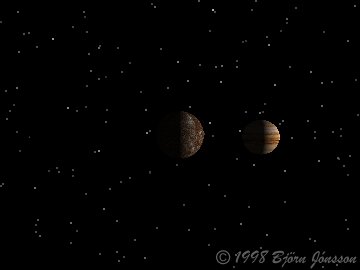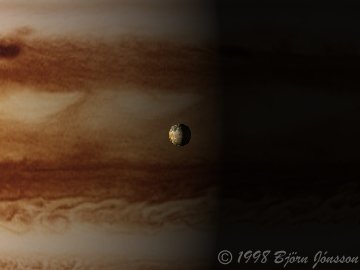









Animations
Rendering stills is only half the fun - this 3D stuff becomes much more "alive" in animations. Below are a few experimental animations from my YouTube and Vimeo pages.
|
Perijove 31 experimental flyby movie from Bjorn Jonsson on Vimeo. |
This is an experimental animation showing Jupiter from the Juno
spacecraft. In the animation we follow the flight path of NASA's Juno spacecraft during
its perijove 31 Jupiter flyby on December 30, 2020. The 7 minute animation shows things
about 13 times faster than they really happened; it covers a period of 94 minutes. The images used for creating the animation were obtained by Juno's JunoCam camera during the flyby. A total of 34 images was used. These images were assembled into several seamless mosaics. Overall, Jupiter's appearance should be fairly realistic but some artistic license has been used. The contrast has been increased a bit to make various details more obvious. To make Jupiter's limb a bit fuzzy and show Jupiter's blue sky at the limb an atmospheric model was used but the atmospheric effects at the limb and in the dimly lit polar regions are somewhat exaggerated. To show Jupiter in its full splendor the animation has a very wide field of view (90░). Image data: NASA/JPL-Caltech/SwRI/MSSS Background starfield data: NASA/GSFC Scientific Visualization Studio Image processing and animation: Bj÷rn Jˇnsson |
|
Flight over Enceladus from Bjorn Jonsson on Vimeo. |
Flight over Enceladus. This is an almost 7 minute animation featuring a digital elevation model (DEM) of Enceladus. Most of the DEM has a resolution of 100-200 meters/pixel; it was created from 55 images obtained by NASA's Cassini spacecraft during three close flybys of Enceladus in 2005. A simple shape from shading algorithm was used to create the DEM, followed by 'destriping' and extensive processing. The DEM covers approximately 50 percent of Enceladus' surface and the flyby and lighting geometry is carefully chosen to make the DEM appear completely global. |
| This is a flight over Mimas' Herschel crater. The altitude above the surface is roughly 30 km (varies a bit) and the field of view is 50░. The digital elevation model (DEM) of Mimas is based on images obtained by NASA's Cassini spacecraft and is actually a combination of two DEMs: One created from stereo imagery and one created using shape from shading (SFS). In the combined DEM the large scale features are from the stereo DEM and the smaller scale features from the SFS DEM. This combines the best of both worlds. The final step was to 'cheat' a bit and add lots of fictional, small scale craters since without them the surface looked too smooth at this close range. These small craters are from a DEM I created from very high resolution images of the Moon obtained by NASA's LRO spacecraft. | |
| This is an animation of Saturn's satellite Enceladus consisting of anaglyphs so you'll need red and blue glasses to view it properly. The animation is based on a digital elevation model (DEM) of Enceladus I'm in the process of creating using a shape from shading technique. This should end up as a global DEM when finished but currently the DEM covers a relatively small part of Enceladus' surface. The altitude above the surface is 25 km, similar to Cassini's altitude during its closest Enceladus flybys. The field of view is 50░. | |
| A flyby of Jupiter's small and irregular satellite Amalthea. The field of view is 40░. While the small scale features on Amalthea's surface are fictional the large scale features and Amalthea's overall shape should be fairly accurate since I used Phil Stooke's shape model of Amalthea as a starting point and then added lots of details, mostly small craters. | |
| This animation of the Moon is based on elevation data from NASA's Lunar Reconnaissance Orbiter spacecraft. Here we are flying above the Moon's surface at an altitude of 700 km. The field of view is 20░. |
Old & historical stuff: Galileo's C9 orbit around Jupiter
Comparing old and new images and animations can be interesting so I'm including a few stills from a very old animation. It was created back in 1997, my first really big (by 1997's standards) animation. Comparing these stills to recent stuff reveals major progress, some of which is thanks to far more powerful computers and some of it is due to better texture maps, better software plus various factors.
Below are some stills from a this old animation. It consists of 2000+ frames and was created back in 1997. It shows the view from the Galileo spacecraft during its ninth orbit (the so called C9 orbit) around Jupiter. This orbit included a very close flyby of the satellite Callisto and a more distant one of Ganymede. It should be noted that these stills and the animation were created using an old version of my renderer and with lower quality planetary maps than I have now. Several years later I did a much better version of this animation.